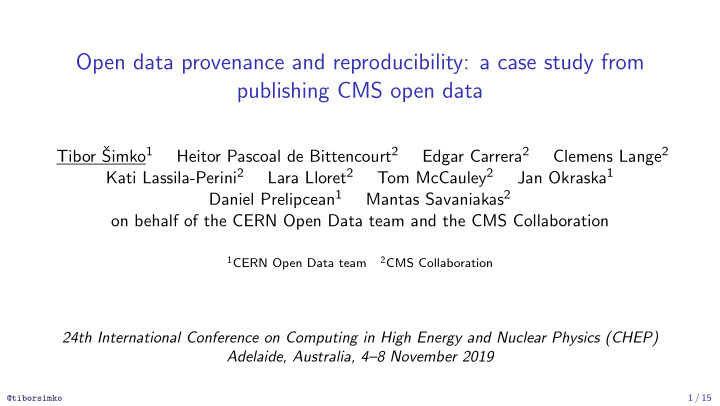



Open data provenance and reproducibility: a case study from publishing CMS open data Tibor ˇ Simko 1 Heitor Pascoal de Bittencourt 2 Edgar Carrera 2 Clemens Lange 2 Kati Lassila-Perini 2 Lara Lloret 2 Tom McCauley 2 Jan Okraska 1 Daniel Prelipcean 1 Mantas Savaniakas 2 on behalf of the CERN Open Data team and the CMS Collaboration 1 CERN Open Data team 2 CMS Collaboration 24th International Conference on Computing in High Energy and Nuclear Physics (CHEP) Adelaide, Australia, 4–8 November 2019 1 / 15 @tiborsimko
CERN Open Data ◮ launched in November 2014 ◮ rich content ◮ collision and simulated datasets for research ◮ derived datasets for education ◮ configuration files and documentation ◮ virtual machines and container images ◮ software tools and analysis examples ◮ total size in November 2019 ◮ over 7’000 bibliographic records ◮ over 800’000 files ◮ over 2 petabytes http://opendata.cern.ch Developed by CERN-IT in close collaboration with Experiments 2 / 15 @tiborsimko
Education-oriented use cases Interactive event display and histogramming for derived datasets 3 / 15 @tiborsimko
Research-oriented use cases Run realistic physics analysis examples Run CernVM Virtual Machines 4 / 15 @tiborsimko
Enables independent theoretical research arXiv:1704.05066 arXiv:1807.11916 arXiv:1902.04222 Searches, QCD jet studies, Machine Learning. . . Over twenty papers citing CMS open data . . . that the CMS collaboration start to cite! 5 / 15 @tiborsimko
New CMS open data release Latest batch of CMS open data was released in Summer 2019 6 / 15 @tiborsimko
Example 1: Data provenance of simulated datasets ◮ full capture of data generation steps ◮ full capture of compute environments ◮ full capture of configuration files ◮ full capture of production scripts Data records come with full provenance information 7 / 15 @tiborsimko
Capturing data provenance via ad-hoc curation techniques CMS DAS CMS McM Dedicated data curation scripts Mining several CMS collaboration sources 8 / 15 @tiborsimko
Harmonising year-dependent sources From year-dependent DAS/McM information to year-independent Open Data JSON schema 9 / 15 @tiborsimko
Example 2: Raw data samples for 2010-2012 data AOD RAW 10 / 15 @tiborsimko
Can we reprocess raw data samples from 2010-2012? Workflow steps to run CMS reconstruction in CMSSW environment 11 / 15 @tiborsimko
Running scientific workflows on containerised clouds ◮ REANA reproducible analysis platform http://www.reana.io ◮ multiple workflow systems (CWL, Serial, Yadage) ◮ multiple compute backends (Kubernetes, HTCondor, Slurm) ◮ multiple shared storage (Ceph, EOS, NFS) reproducibility code + data + environment + workflow 12 / 15 @tiborsimko
Preserving CMS software stack environment Condition data for open data analyses are available on “live” CVMFS CMSSW docker image with “embedded” CVMFS 13 / 15 @tiborsimko
Automated reconstruction workflows dataset=Jet year=2011A 1 input parameters 5 serving open data files ↓ ↓ → → → 2 workflow factory 4 run by REANA platform 3 6 output reana.yaml histograms Parametrised workflow runnable on REANA reproducible analysis platform 14 / 15 @tiborsimko
Conclusions CMS open data now contains detailed provenance information ◮ knowing “how the data came about” enhances current knowledge and future reuse ◮ capturing data provenance requires non-trivial information hunt and harmonisation ◮ a posteriori approach: running after ∼ 5 year old data and procedures ◮ a priori approach: ultra legacy run to generate preservation-friendly assets? Successful RAW to AOD reconstruction tests on open data ◮ AOD reconstruction and histogram verification permitted to validate approach ◮ using non-production compute environment ensures reproducibility http://opendata.cern.ch 15 / 15 @tiborsimko
Recommend
More recommend